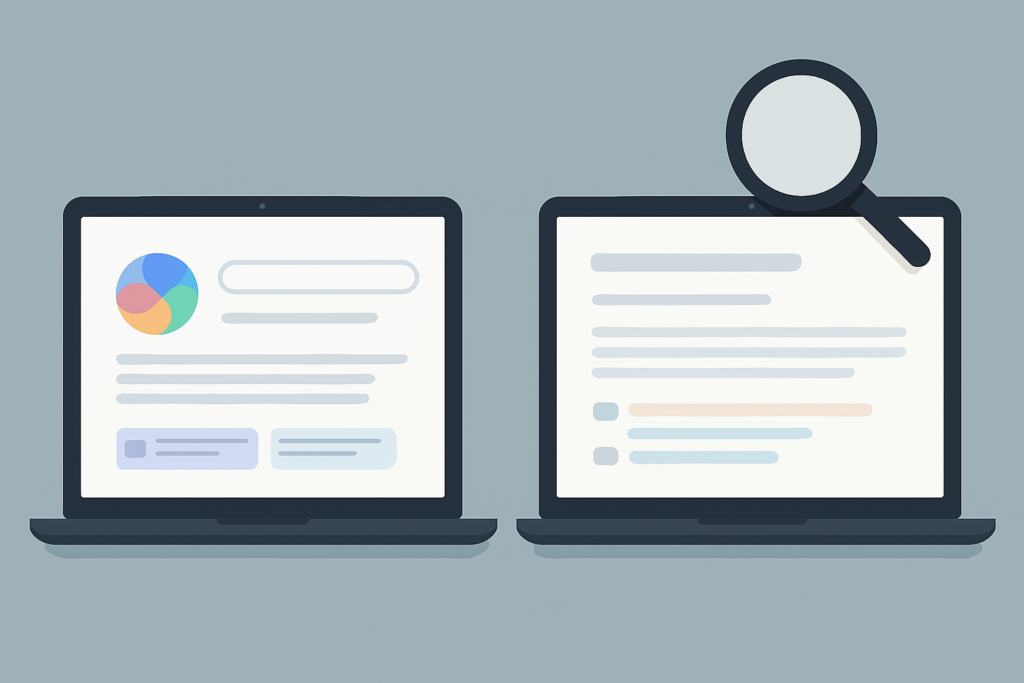Everyone’s talking about Perplexity like it’s the new Google. And to be honest, that comparison isn’t completely off. The difference is that Perplexity doesn’t try to organize the world’s information—it just gives you the part you need, fast, with sources you can actually trace.
At first glance, it feels like magic. Ask a question, get a clean, structured answer, with citations you can drill into. No ads, no SEO content farms, no bouncing between five tabs to piece together the real story. For anyone in tech, media, or product work, that’s a breath of fresh air.
But like most tools in the AI space right now, the more you lean on it, the faster you run into its limitations.
Let’s break down why Perplexity is gaining traction—especially among AI YouTubers and tech creators—and where the real boundaries of its usefulness show up.
What Is Perplexity, Really?
Perplexity pitches itself as an “answer engine.” But strip away the branding, and what you’ve got is a tightly tuned combination of:
- A fast, conversational LLM interface
- A real-time search and retrieval system
- Source-linked summaries across multiple domains
It’s not just ChatGPT with citations. It’s closer to a streamlined research assistant that knows how to synthesize the web for you without overwhelming you with noise.
You type a question. It pulls in relevant results from the open web, academic databases, Reddit, YouTube transcripts—depending on your filters—and builds an answer that actually points somewhere. For tech-savvy users, that’s a huge value-add.
Why AI Creators Are All Over It
The explosion of Perplexity in the AI YouTuber and indie creator space isn’t an accident. It fits neatly into the way modern creators think and work.
Fast Ideation
When you’re trying to spin up content fast—video scripts, blog outlines, comparative tool breakdowns—Perplexity gives you instant angles. It’s like having a research intern who doesn’t sleep and never asks for clarification.
Built-In Credibility
The citations Perplexity includes in every response are a lifesaver for anyone putting content into the public domain. Want to reference a Reddit thread, quote a paper, or cite a product’s official docs? You get that inline, with links, without any digging.
Zero Friction (At First)
You don’t even need to log in. Fire up the site, type your question, get an answer. For creators who bounce between apps, tabs, and tools, that kind of low-friction UX is gold.
Where You Hit the Wall

Of course, the magic doesn’t last forever. Here’s where most people start to feel the edges of the free tier.
Limited Pro Model Queries
Yes, you can access GPT-4, Claude 3, and Mistral Large—but only a few times per day. After that, Perplexity quietly downgrades to a faster, cheaper model (usually GPT-3.5 or similar), which can impact quality depending on your query.
There’s no warning. No clear usage counter. You just start noticing the answers feel… off.
Soft Rate Limits
Ask too many questions in a short time and you’ll hit a temporary cooldown. The site may throttle responses or ask you to try again later. It’s subtle, but it’s there.
Focus Filters Are Paywalled
One of the most powerful features—filtering sources by Reddit, academic papers, YouTube, or news—is mostly locked behind the Pro plan. You might get a taste, but if you want to dig deep consistently, you’ll need to pay.
No Memory or History
Unless you’re a subscriber, you don’t get thread history. Close the tab, and your session is gone. No bookmarking, no long-term projects, no back-and-forth context.
The $20/month Threshold
It’s the same price as ChatGPT Plus and offers similar benefits: unlimited Pro model access, full source filtering, saved history, and faster performance. Whether that’s worth it depends on how central it is to your workflow.
Where Perplexity Shines (And Where It Doesn’t)
Let’s talk about practical use cases.
What It Does Well
- Quick research: Need to get up to speed on a new framework, library, or concept? This is your tool.
- Sourcing multiple perspectives: Perplexity excels at stitching together viewpoints across different sources.
- Getting unstuck: When you’re in the middle of a project and need fast, structured input, it delivers.
Where It Falls Short
- Multi-step reasoning: It can’t hold extended logic over long sessions the way a tuned GPT-4 or Claude 3 chat might.
- Persistent workflows: You can’t rely on it to remember what you were doing yesterday.
- Project-level thinking: This is still a tool for rapid information gathering, not long-form planning or ideation.

Why It’s Working (From a Product Strategy POV)
From a product standpoint, Perplexity is winning because it under-promises and over-delivers.
It doesn’t try to be everything. There’s no bloated interface. No AI avatars or overengineered dashboards. Just fast input → useful output.
They nailed a few core decisions:
- Minimal UI, maximal utility
- Citation-first mindset (fixes the trust problem most AI tools have)
- Performance that feels immediate
- Feature gating that’s… annoying, but well-paced
In a world full of tools that overwhelm users with options, Perplexity is fast, focused, and just smart enough to feel like an edge.
Tradeoffs to Be Aware Of
No tool is perfect, and pretending otherwise helps no one.
- Hallucination risk still exists. Just because it cites sources doesn’t mean it interpreted them correctly.
- No plug-and-play integrations yet. If you want to pull structured answers into Notion, Obsidian, or your own tools, you’re out of luck for now.
- Learning curve for the filters. Knowing when to use Arxiv vs Reddit vs All Sources takes experimentation.
If you’re hoping this will replace your need for ChatGPT, Claude, and your own brain—it won’t.
Final Takeaway
Perplexity isn’t here to replace your tools. But it does something most AI products struggle to do: it gets out of the way.
If you spend your time making things—content, products, strategies, systems—it’s one of the fastest ways to go from “I need to figure this out” to “Here’s a direction worth exploring.”
It won’t plan your business. It won’t execute a marketing strategy. But it will make you faster at getting from question to clarity—and sometimes, that’s all you need.
Your move: Try it for a week. See what it replaces. If it sticks, that’s your answer.
